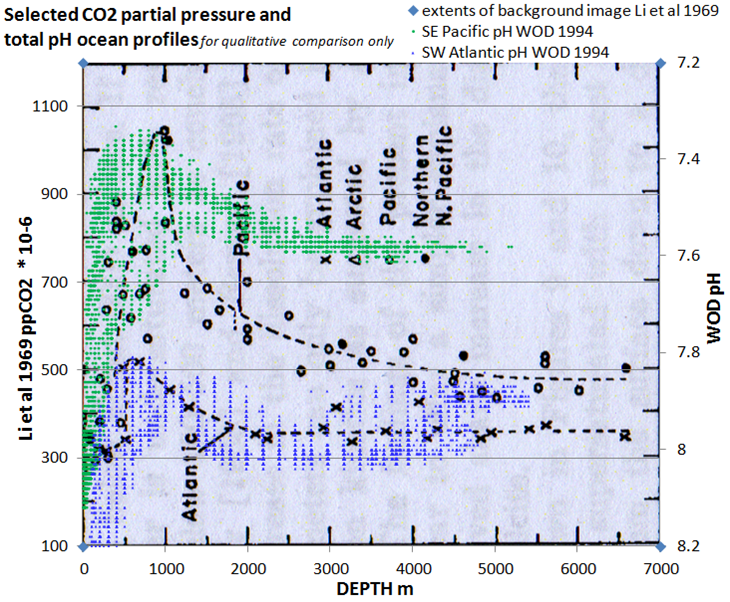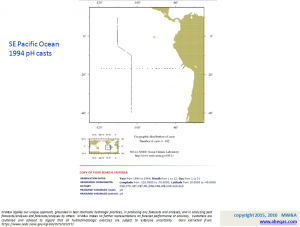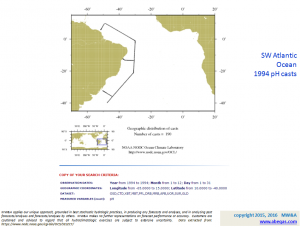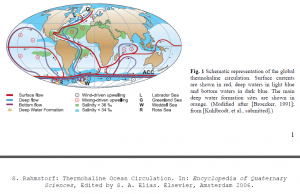Update, 2021, I’m taking this post out of cold storage for a time. See more recent posts such as this one on DIC (dissolved inorganic carbon) and later ones, for what many might find to be data based corroboration.
original from 2017 below
___________________________________________________________________________________________________
My research strategy has focused on data and acceptable simplifications, geared towards practical forecasting applications, but open to other insights. As such, I have elected to employ the QG approximations to both atmospheric and oceanic currents. This has been fertile ground, and previous posts attest to the intriguing connections of QG products in comparison to everything from Earth’s jet streams to Jupiter’s Great Red Spot.
I am also known in some media for my attention to the full WOD data sets for ocean pH. In a past effort I developed the featured image, which compares ocean pH profiles to dissolved CO2 profiles for the South Atlantic and South Pacific ocean regions that surround South America. The ocean pH data are for the year 1994 and the dissolved CO2 data are from a paper by Li (1969). Clearly they show consistent trends. The next two figures detail the mapping of the 1994 data sets in the two ocean regions.
One factor of note for the featured image is that pH is generally higher for any given depth in the southwest Atlantic ocean compared to the southeast Pacific. I decided to begin to explore this anomaly from a QG perspective and that drew me closer to the prevailing ocean circulation descriptions of relevance. The last data map above also corresponds somewhat to the general position of the South Atlantic Gyre as the next image suggests (also many posts of mine can be examined to confirm at least for overlying atmosphere).
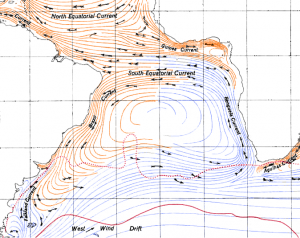
By Jack · talk · – cropped from Image:Ocean currents 1943 (borderless).png, Public Domain, https://commons.wikimedia.org/w/index.php?curid=3841905
Geostrophic perspectives are sometimes used in oceanography to explore patterns of circulation of mass and energy. However the notion of the Atlantic Meridional Overturning Circulation (AMOC) and its cousin the Thermohaline Circulation (THC) appear in my view at this time to violate those principles on the global scales that I address. For example, from a geostrophic perspective, the oceans are simply another fluid on the surface of the earth, just as the overlying atmosphere is. Accordingly the Coriolis effect and equator to polar heat advection are known to apply. Indeed, the parent image of the figure above is included below and shows a derived global ocean circulation pattern from the 1940s that is amazingly similar to the global QG circulation plots I routinely feature at this site (for example, here). For convenience I refer to this figure as “Ocean_currents_1943”.
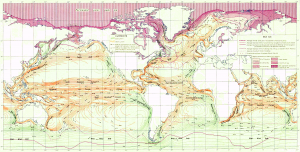
Another aspect of the QG approximation that I employ is the simplification of only plotting information for the full atmosphere as compared to any particular layer (such as the PBL or the tropopause). The same simplification of the full layer can apparently be adopted in some respects for ocean circulation patterns. The image above implicitly verifies that. Later oceanographic studies had continued to confirm these circulation patterns even with the inclusion of density driven baroclinic effects. Notably Reid (1989) describes a vast anticyclonic south Atlantic gyre which at the shallower depths extends across most of the south Atlantic from west to east and from 15 deg S to 40 deg S. The gyre is described to extend to great depths, such that even below 1500 m depth, its extent still reaches across the Brazil Basin east to the mid Atlantic ridge and south to the Rio Grande Rise. No lower depth of the gyre is described and presumably this indicates a full ocean depth to the gyre.
How is such an approximation to be reconciled with plots such as the next image taken from Rahmstorf (2006) regarding the AMOC? In that image, there is no hint of a South Atlantic Gyre. Rather ocean currents are asserted to cross from the Southern Hemisphere into the Northern Hemisphere within the Atlantic. Notably that is not asserted for the Pacific. For what it may be worth, the green zones of higher salinity in the image remarkably appear to correspond to the major gyres. The high salinity zones are consistent with general and QG understanding of higher atmospheric temperatures within those tropical gyres which produce greater evaporation, which leads to greater concentrations of dissolved salts. I haven’t found a corresponding discussion within the source document for this figure. Rather there is only a single mention of a gyre and that is in regard to a Northern Hemisphere Gulf Stream discussion.
As I’ve begun to read more deeply into the AMOC narrative, I can’t seem to find data/observation based papers that support the Rahmstorf paper(s). Any are welcome to email me to enlighten, even as I continue to research this myself. Primary contemporary sources appear to neglect data, as well as the entire south Atlantic portion of the AMOC. Instead they appear to rely on speculative graphics and complicated appeals to chaos theory along with uncalibrated and speculative global coupled atmosphere ocean circulation models. For examples: NCAR presentation on AMOC, EGU General Assembly AMOC paper, AMS paper, Another AMS paper, and many more. One presentation (NCAR) indicated that the AMOC cannot actually be observed. My guess is that most readers who have heard of the AMOC did not know this. I didn’t until I decided to read the above references. It is particularly noteworthy to me because the South Atlantic Gyre can be observed, can explain much if not most of the circulation there, yet is omitted from most AMOC narratives.
Obviously (as the AMOC and the THC notions promote), density differences do impact ocean flows. But it appears that the scope and scale of this impact have been over attributed, especially in comparison to QG forcings and associated gyres.
Ocean pH information may add value to this exploration. Returning to the pH plots, it appears that the pH samples of the Atlantic fall within the South Atlantic Ocean Gyre. The plots also suggest a uniform chemistry below the pelagic zone in each ocean study area. It is also widely reported that the Atlantic Ocean is warmer in general than the Pacific. Also, slowly rotating quasi stationary subtropical gyres in the atmosphere are warmer than surrounding air parcels. I suspect the same applies to the ocean gyres that underlie them.
Although contemporary ocean science sources appear to marginalize the significance of temperature influences upon pH, I choose not to. Higher temperatures are ubiquitously associated with higher pH of natural continental waters, all other things being equal. This is typically because the CO2 solubility drops as temperature increases.
When actual observations of temperature, QG and pH are not disregarded a plausible description of Atlantic circulations may emerge:
- The circulation in the South Atlantic may be dominated by QG principles along with a roughly full ocean thickness gyre circulating ccw (counter clockwise).
- The added warmth of that domain leads to higher ocean pH there, at any depth in comparison to ocean pH in the southeastern Pacific.
- The AMOC/THC notion of a massive, persistent, and coherent current of water and thermal energy, directed from the Southern Hemisphere across the equator to the Northern Hemisphere only in the Atlantic is challenged by the first two points.
AMOC/THC advocates and I cannot both be right, so I’ll keep exploring as I can, to confirm or correct, and will update in a later post or two. At this point having reviewed some of the most widely cited contemporary AMOC papers and given their disregard of observations, I’m inclined to believe that the AMOC was never observed and never will be.
References
Reid, Joseph L. 1989. “On the total geostrophic circulation of the South Atlantic Ocean: Flow patterns, tracers, and transports” Progress in Oceanography. Vol. 23, Issue 3, 1989, Pages 149-244
Featured image adapted from NOAA WOD, and
Li, Y.H., T. Takahashi, and W.S. Broecker, 1969, “Degree of Saturation of CaCO3 in the Oceans”, Journal of Geophysical Research Vol 74 No. 23 October 20, 1969
South Atlantic Gyre close up image after:
By Jack · talk · – cropped from Image:Ocean currents 1943 (borderless).png, Public Domain, https://commons.wikimedia.org/w/index.php?curid=3841905
Ocean_currents_1943 image from
http://www.lib.utexas.edu/maps/world_maps/ocean_currents_1943.jpg
Final image from
S. Rahmstorf: Thermohaline Ocean Circulation. In: Encyclopedia of Quaternary
Sciences, Edited by S. A. Elias. Elsevier, Amsterdam 2006.
 4354total visits,2visits today
4354total visits,2visits today
